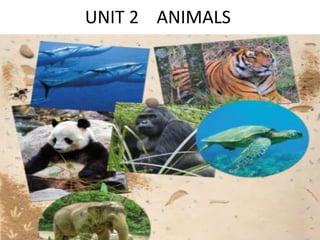
Unit 2 animals
- 2. VERTEBRATES AND INVERTEBRATES. What is a skeleton for ? The skeleton supports the body. The skeleton is made up of bones. There are many different animals. We can divide them into two main groups: animals that have a spine (backbone) and animals that don´t have a spine.
- 3. VERTEBRATES The name for animals with a spine is vertebrates. Vertebrates have a skeleton inside them. Most vertebrates have a head, a torso, limbs and a tail. tail limbs head torso spine / backbone
- 4. INVERTEBRATES The name for animals that don´t have a spine is invertebrates. They don´t have a skeleton inside them. They´re usually smaller than vertebrates. Invertebrate animals protect their bodies in different ways. Some invertebrates have a shell. Some invertebrates have an exoskeleton. oyster cocroach
- 5. Some invertebrates have a shell to protect their bodies, for example oysters and snails. oyster snail shell
- 6. Some invertebrates have an exoskeleton. This is hard like a skeleton but it´s outside the body. .Some invertebrates such as cocroaches, have a thin exoskeleton. . Some invertebrates, such as crabs, have a thick exoskeleton. . Some invertebrates don´t have any protection. They have a soft body, for example, caterpillars and worms.
- 7. Are they vertebrates or invertebrates? bird mosquito bluefin tuna prawn Blue whale crab gorilla oyster
- 8. Are they vertebrates or invertebrates? ant pig cocroach fish butterfly frog caterpillar worm tiger rabbit
- 9. VERTEBRATES FISH AMPHIBIANS REPTILESBIRDSMAMMALS We can classify vertebrates into five groups. Animals in each group have common characteristcs.
- 10. MAMMALS . Mammals have hair or fur. . They breathe with lungs and they usually feed their babies with milk. . Most mammals live on land. Some mammals live in water, for example dolphins. . But only one mammal, the bat, can fly.
- 11. BIRDS . Birds have two wings and are covered with feathers. . They have a beak and two legs. . They use feathers for flying, keeping warm and attracting other animals . They breathe with lungs. . Most birds can fly but penguins can´t.
- 12. FISH Fish live in water. They have scales and use fins to swim. They breathe with gills. There are more than 30 000 known types of fish in the world. finsscales gills tail
- 13. AMPHIBIANS . Amphibians have moist skin. . When they´re young they breathe with gills, but later they develop lungs. . They can live on land or in water. . Adult amphibians have four legs.
- 14. REPTILES . Reptiles have dry, scaly skin. . They breathe with lungs. . They live on land. . Most reptiles have 4 limbs but some reptiles have no legs.
- 15. . Most animals on Earth are invertebrates. . There are many different groups of invertebrates. . Some invertebrates, such as jellyfish, live in water. . Others, such as earthworms, live on land. . Some, such as mosquitos can fly. INVERTEBRATES
- 16. INVERTEBRATES WORMSARTHROPODS MOLLUSCS MYRIAPODS INSECTS ARACNIDS BIVALVES CRUSTACEANS GASTROPODS CEPHALOPODS Here are three groups of invertebrates.
- 17. ARTHROPODS . Arthropods are the biggest group of invertebrates. . Most arthropods have 3 body parts: head, thorax and abdomen. . Many of them have antennae and some have wings too. . Insects are arthropods. . Some arthropods, such as insects have six legs. . Others such as spiders have eight legs. . There are even arthropods with more than a hundred legs. INSECTS MYRIAPODS ARACNIDS CRUSTACEANS Beetle Bee Ant Scorpion
- 18. Molluscs have a soft, muscular body. Many molluscs live in the sea. MOLLUSCS GASTROPODS BIVALVES CEPHALOPODS snail mussels oysters squid octopus
- 19. . Worms have a long, soft body. . Some live on land and others live in water. . Some worms are parasites, for example, leeches and flatworms. . They live inside or on the skin of another animal and feed on them. WORMS A leech is a worm. Flatworms live in water.
- 21. Not all animals eat the same food. . Some animals only eat plants; they are herbivores. rabbit panda bear elephant giraffe cow goat kangaroo sheep NUTRITION
- 22. . Some animals only eat other animals; they are carnivores. For example: lynx spider lion cat eagle wolf crocodile dolphin
- 23. . Some animals eat plants and animals; they are omnivores. bear mussel pig hen monkey
- 24. REPRODUCTION Not all animals reproduce in the same way. .Some animals are born directly from their moter. They are viviparous. Mammals are viviparous. seal Kangaroo sheep
- 25. Crocodiles lay hard eggs. Frogs lay soft eggs. . Some animals are born from eggs. They are oviparous. . All invertebrates are born from eggs. . Some vertebrate groups are born from eggs too: fish , amphibians, reptiles and birds. . Some animals such as birds lay eggs with a hard shell. Other animals such as fish lay soft eggs.
